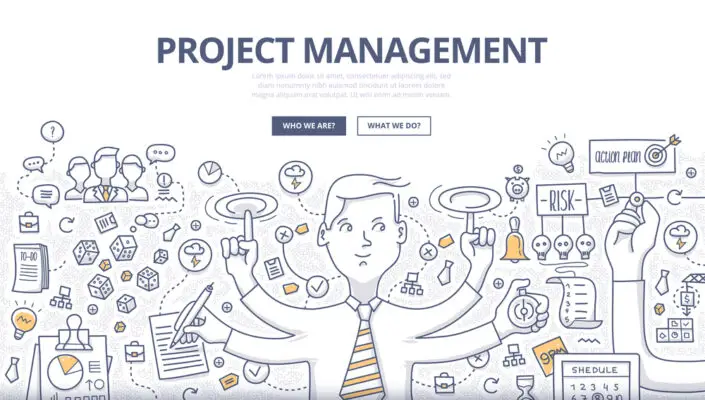Managing a website build requires a systematic approach and effective communication with the project team and stakeholders. The first step is to define the project scope, objectives, and deliverables.
This includes identifying the target audience, determining the website’s functionality, and setting clear goals for the project.
Next, it is essential to create a detailed project plan that outlines all the tasks, timelines, and dependencies.
This plan should be regularly updated and shared with the team to ensure everyone is on the same page. Throughout the project, it is crucial to monitor progress, track milestones, and manage any issues or risks that may arise.
Effective communication with the project team, stakeholders, and any external vendors or suppliers is essential to ensure the website build stays on track and meets the desired outcomes.
Regular status meetings, progress reports, and feedback loops should be established to keep everyone informed and address any concerns or changes promptly.
Website development projects require effective project management to ensure successful outcomes. This article aims to provide a comprehensive guide on how to project manage a website build.
It begins by defining project management and its importance in website development.
The article then explores the process of defining the project scope and objectives, followed by a discussion on planning and executing the project.
Website developers can improve their project delivery by following structured project management principles.
This helps them ensure that projects are completed on time, within budget, and meet stakeholders’ satisfaction.

What is project management?
Effective project management is essential for website builds due to several reasons.
Firstly, it helps ensure the project is completed within the allocated time frame and budget. By carefully planning and organizing the various tasks involved, project managers can proactively identify and mitigate potential risks.
Additionally, project management facilitates effective communication and collaboration among team members, leading to improved efficiency and a higher-quality end product.
Why is it essential for website builds?
It is crucial to consider website builds as essential due to their ability to establish an online presence and facilitate effective communication with users.
Project management methodologies play a significant role in ensuring the successful completion of a website development project.
Project teams, consisting of professionals from various disciplines, collaborate to ensure the project requirements are met within the given project schedule.
Effective communication is crucial throughout the project phases to keep all stakeholders informed and aligned with the project goals.
Project management tools aid in organizing and tracking project progress, enabling the project manager to make informed decisions and mitigate risks.
Defining the Project
This will focus on the key aspects of setting project goals, gathering requirements and information, putting together a timeline/schedule, and assigning resources/staffing the project team.
Setting project goals involves determining the desired outcomes and objectives that the project aims to achieve.
Gathering requirements and information entails collecting and analyzing the necessary data and specifications for the project’s success.
Creating a timeline/schedule involves creating a structured plan that outlines the sequence of activities and their deadlines.
Assigning resources and staffing the project team involves identifying and allocating the necessary personnel and resources to ensure the successful execution of the project.
Setting Project Goals
One important step in project management for a website build is establishing clear and measurable goals.
This ensures that all stakeholders are aligned and clearly understand what needs to be achieved.
To set project goals effectively, consider the following steps:
- Define the project’s scope: Identify the tasks and deliverables that must be completed.
- Involve key stakeholders: Engage stakeholders early on to gather their input and ensure their needs are considered.
- Conduct a kickoff meeting: This meeting provides an opportunity to communicate project goals, roles, and expectations to the team.
- Utilize a project management platform: A project management platform can help organise tasks, track progress, and facilitate communication between team members.
Following these steps, project managers can ensure that project goals are well-defined and achievable, setting the foundation for a successful website build.
Furthermore, regular testing and collaboration with the development team and agency will help to ensure that the project stays on track and meets the desired outcomes.
Gathering Requirements & Information
To gather requirements and information effectively for a project, stakeholders should conduct thorough research and analysis to ensure a comprehensive understanding of the necessary elements and specifications.
This process is crucial to the success of any project, especially when it comes to complex projects such as website builds.
Project management software can be used to streamline the gathering of requirements and information by providing a centralized platform for collaboration and documentation.
Creative teams, including design and development teams, can use this software to track project milestones, manage project timelines, and monitor project status.
Additionally, stakeholders should consider project goals, search engine optimization requirements, and communication channels, such as emails, to ensure that all necessary information is gathered and incorporated into the project plan.
Putting Together a Timeline/Schedule
A well-structured timeline/schedule is essential for organizing and coordinating a project’s various tasks and milestones.
To put together an effective timeline/schedule for a website build project, the following steps should be considered:
- Create a detailed project plan: Identify the project stages, such as requirements gathering, design, development, and testing. Break down each stage into smaller tasks and determine their dependencies.
- Assign task owners: Identify team members responsible for each task and allocate resources accordingly. This ensures clear accountability and efficient task execution.
- Conduct regular team meetings: Schedule meetings to review progress, address issues, and ensure alignment among team members. This promotes effective communication and collaboration throughout the project.
- Utilize communication tools: Implement communication tools such as project management software or collaboration platforms to facilitate seamless information sharing and updates among team members.
If the project manager follows these steps, they can develop a well-organized timeline/schedule that fosters collaboration, guarantees dedicated tasks, and enables frequent monitoring and adjustments.
This approach enables better coordination and a smoother progression towards the project’s ultimate goal.
Assigning Resources/Staffing the Project Team
To effectively manage a website build project, it is crucial to assign appropriate resources and staff to the project team.
With the increasing popularity of agile methodologies in website development, the project team should consist of individuals with diverse skill sets that align with the project requirements.
Carefully selecting team members, project managers can ensure the right expertise is available throughout the design and development process.
Additionally, a design project management tool can help streamline communication and collaboration among team members, keeping the project on track and on time.
Effective project management involves assigning resources and implementing communication strategies to ensure that all stakeholders are informed and engaged throughout the project.

Planning & Execution of the Project
In the planning and execution of a project, choosing the right methodology is crucial.
Different methodologies, such as Agile and Waterfall, offer distinct approaches to project management, each with its own advantages and limitations.
It is important to carefully consider the project requirements, team dynamics, and stakeholder expectations when selecting a methodology to ensure effective project planning and execution.
Additionally, utilizing effective tools and processes can enhance the project’s success by promoting collaboration, communication, and efficiency throughout the project lifecycle.
Choosing a Methodology (Agile, Waterfall, etc.)
When selecting a methodology for a website build, it is critical to carefully consider the strengths and weaknesses of various approaches such as Agile and Waterfall.
Both methodologies have their own unique characteristics that can impact the success of a project. To help make an informed decision, here are four key considerations to keep in mind:
- Agile project management: Agile allows for flexibility and adaptability throughout the project, emphasising collaboration and iterative development. It is well-suited for projects with evolving requirements and a need for quick feedback.
- Waterfall project management process: Waterfall follows a sequential approach, with each phase dependent on the completion of the previous one. It is suitable for projects with well-defined and stable requirements, where a detailed project plan template can be followed.
- Retrospective meetings: Agile methodologies often incorporate retrospective meetings to reflect on the project’s progress and identify areas for improvement. This allows for continuous learning and refinement throughout the development project plan.
- Dedicated project manager: Regardless of the chosen methodology, having a dedicated project manager is crucial. They will oversee the project, coordinate tasks, and ensure key deliverables are met.
Considering these crucial steps and the specific requirements of the website build, a thorough evaluation of Agile and Waterfall methodologies will help determine the most suitable approach for the project.
Utilizing Effective Tools & Processes
Utilizing effective tools and processes is essential for ensuring the smooth execution and successful completion of a development endeavour.
In website development projects, several tools and processes can aid in managing the project efficiently.
One such tool is search, which can help conduct research and gather information related to the project.
Another useful tool is Google Drive, which allows for collaborative document creation and sharing.
Design project management software can assist in organizing project details and tracking progress.
Content management systems can facilitate the management and delivery of website content.
Additionally, implementing a design project management process and workflow can help streamline the project and ensure that tasks are completed in a timely manner.
Finally, a project dashboard can provide a centralized overview of the project’s status and key metrics.
Frequently Asked Questions
What Are a Project Manager’s Key Roles and Responsibilities in Website Development?
A project manager’s key roles and responsibilities in website development involve overseeing the entire project lifecycle.
They also coordinate tasks and resources, ensuring adherence to timelines and budgets, managing stakeholder expectations, and ensuring quality control.
How Can Project Managers Effectively Communicate and Collaborate With Stakeholders During a Website Build?
Effective communication and collaboration with stakeholders during a website build is essential for project managers.
They must establish clear channels of communication, actively listen to stakeholders, and provide regular updates to ensure alignment and address any concerns or changes.
What Common Challenges or Obstacles Project Managers May Face During the Website Build Process?
Some common challenges or obstacles that project managers may face during the website build process include scope creep, resource allocation, stakeholder management, technical issues, and timeline delays.
These challenges can impact project success and require effective project management strategies to overcome.
How Can Project Managers Ensure the Website Development Project Stays Within Budget and Timeline?
To ensure that a website development project stays within budget and timeline, project managers must employ effective strategies such as setting clear project objectives.
It conducts regular progress assessments, implements risk management practices, and maintains open communication channels with stakeholders.
What Strategies Can Project Managers Use to Effectively Manage Risks and Mitigate Potential Issues During the Website Build?
Strategies employed by project managers to effectively manage risks and mitigate potential issues during website builds are crucial.
These strategies involve identifying and analyzing risks, developing contingency plans, and implementing proactive measures to prevent or minimize adverse consequences.

Conclusion
Project management is an essential aspect of any website build. It involves defining the project planning and executing it to ensure completion.
Following a systematic approach, project managers can effectively oversee all aspects of the website build, including budgeting, scheduling, and resource allocation.
This helps to keep the project on track and ensures that all stakeholders are informed and involved.
With proper project management, website builds can be completed efficiently and meet the desired objectives.
In conclusion, project management plays a crucial role in the success of website builds by providing structure, organization, and effective communication throughout the process.

Chris Ekai is a Risk Management expert with over 10 years of experience in the field. He has a Master’s(MSc) degree in Risk Management from University of Portsmouth and is a CPA and Finance professional. He currently works as a Content Manager at Risk Publishing, writing about Enterprise Risk Management, Business Continuity Management and Project Management.

